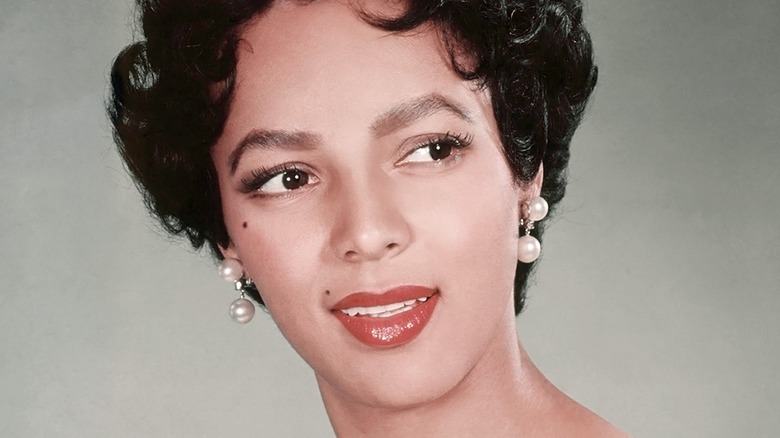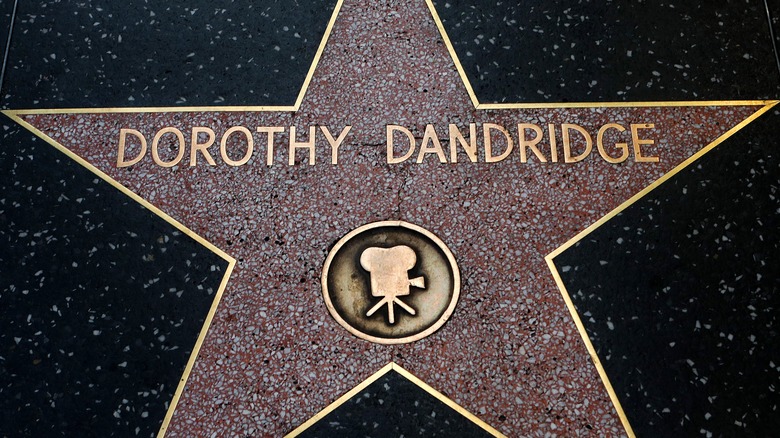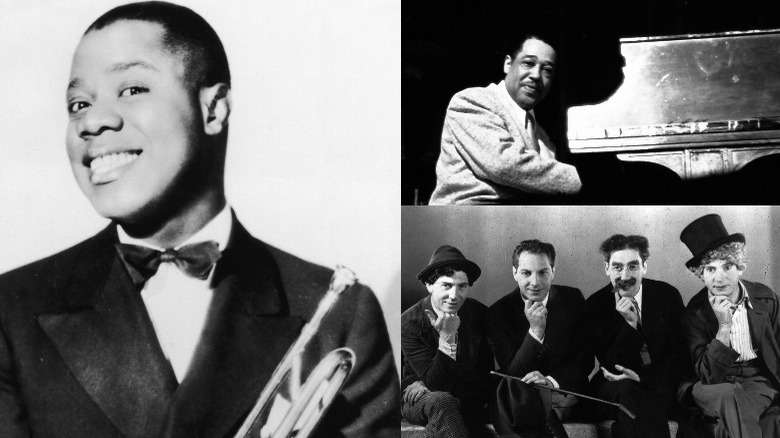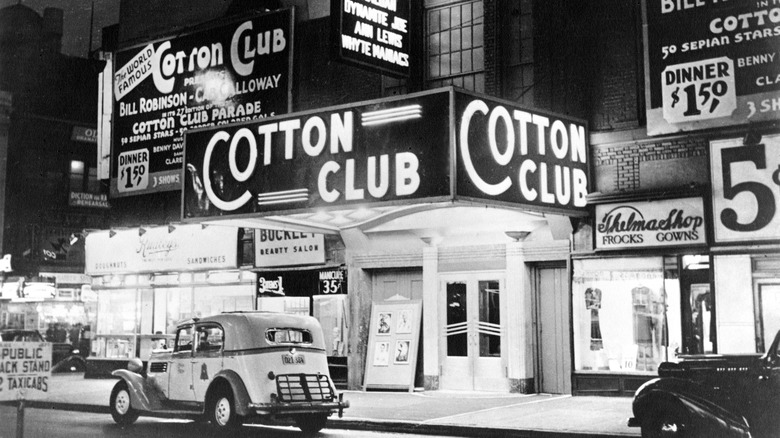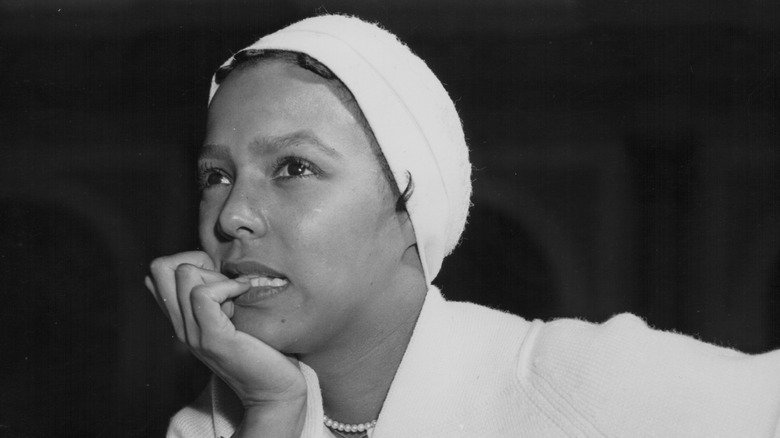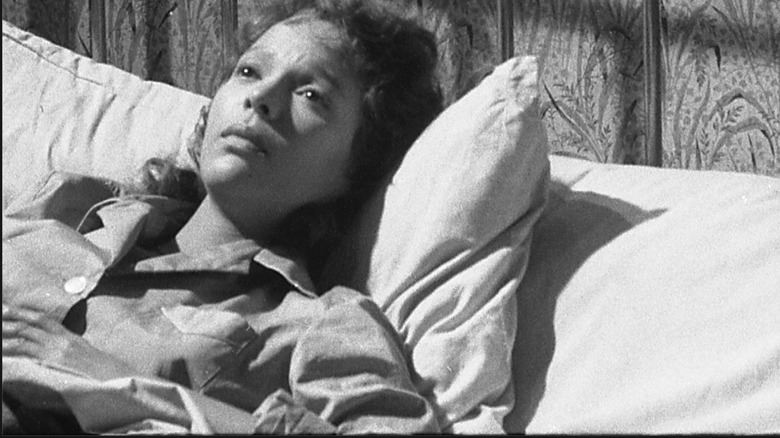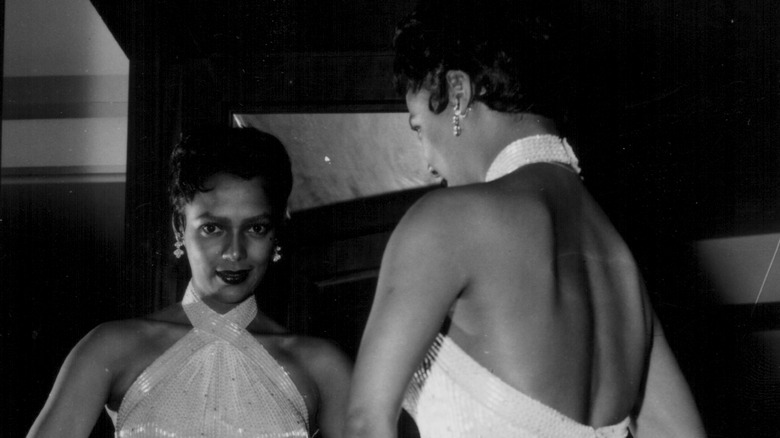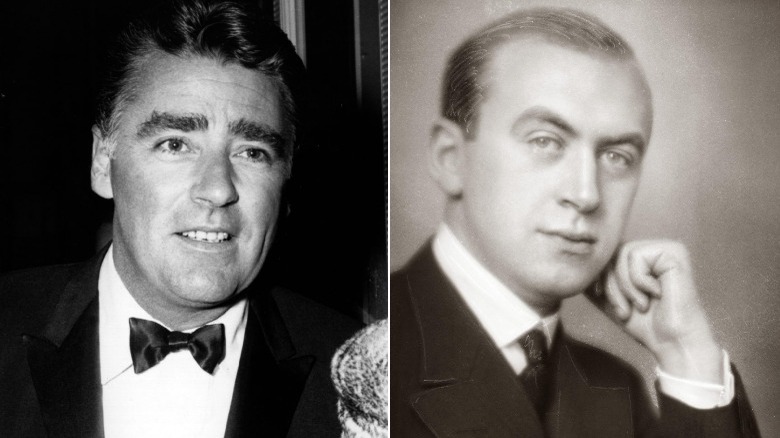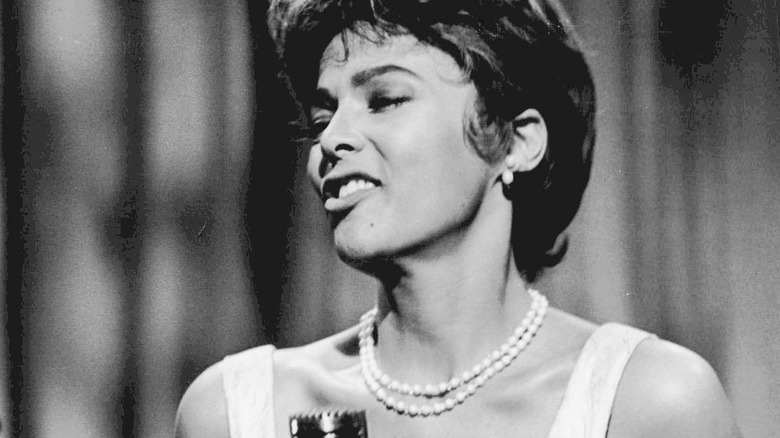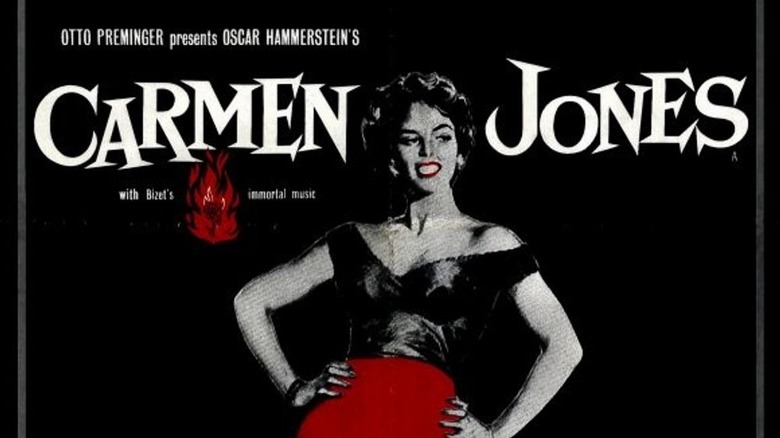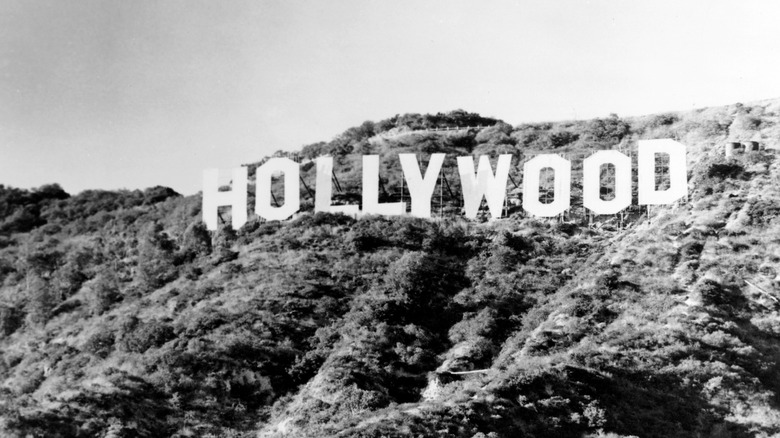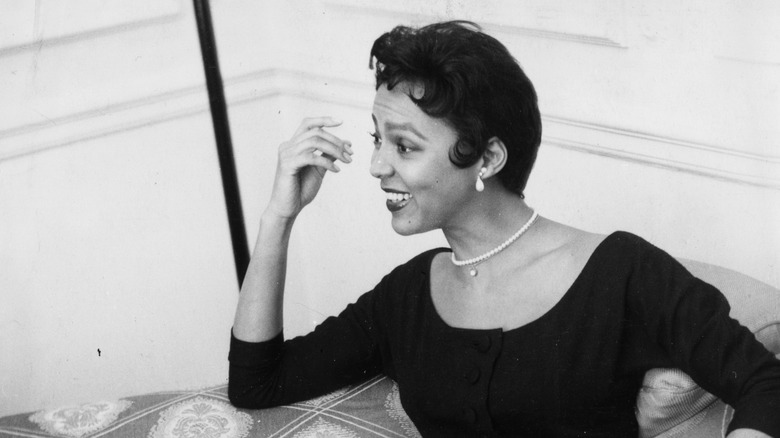The Untold Truth Of Dorothy Dandridge
Dorothy Dandridge has been called the first Black movie star. She thrived in the golden age of Hollywood, a time in cinema that was marked by glamorous performers like Marilyn Monroe, Elizabeth Taylor, and Grace Kelly. As described in Donald Bogle's biography "Dorothy Dandridge," she changed how America imagined its Hollywood stars, expanding the definition beyond blonde bombshells.
Dorothy Dandridge perfected an image that was confident, sophisticated, and seductive. Privately, Dandridge suffered personal tragedy, flew from one chaotic romance to another, and endured years of bigotry within the film industry. She was beloved by her audiences, Black and white alike. She was known as a beauty icon and a sex symbol, but she was also a powerhouse of talent. In addition to a voice that had made her a nightclub singing sensation, Dandridge was a thoughtful and nuanced actress, transforming simple roles into complex characters.
The following article contains references to addiction, abuse, and mental health struggles. If you or anyone you know is experiencing these issues, help is available. Contact SAMHSA's National Helpline at 1-800-662-HELP (4357), RAINN's National Helpline at 1-800-656-HOPE (4673), or the National Suicide Prevention Lifeline by calling 1-800-273-TALK (8255).
Dorothy started performing at 3 years old
While pregnant with her daughter Dorothy, Ruby Dandridge left her husband, taking her young daughter Vivian with her. As described in a 1998 documentary from Biography, Ruby had a passion for performance and often sang at her church. When she was only 3 years old, Dorothy began performing with her sister Vivian. In just a few years, she would be on her way to Hollywood.
When Dorothy and Vivian were young, their mother Ruby welcomed a new partner into their home, a woman named Geneva Williams (sometimes known as Eloise Matthews.) As described in "Dancing on the White Page," Williams claimed to have been a music teacher at the prestigious Fisk University, but no evidence has been found that she worked or studied there. While Ruby Dandridge worked full time, Williams, who was frequently physically abusive to the children, was left in charge of Dorothy and her sister.
Williams taught the girls singing and dancing, and prepared them for their new lives as performers. Dorothy and her sister Vivian were known as "the Wonder Kids," and performed around the country. Soon they were making enough money to support their entire family.
She worked with the Marx Brothers, Louis Armstrong, and Duke Ellington
Dorothy Dandridge and her family moved to Los Angeles, California, in the early 1930s. Former "Wonder Kids" Dorothy and Vivian recruited their friend Etta Jones, and the trio arrived in Hollywood as "the Dandridge Sisters."
Before Dorothy Dandridge was 15, she had made her film debut. As described in "African American Lives," the Dandridge Sisters signed a contract with Warner Brothers to appear in an upcoming film: the Marx Brothers' classic comedy "A Day at the Races." Over the next few years, she would have several more small roles in films, including "Going Places," in which she sang with the iconic Louis Armstrong. As noted by Biography, while Dorothy Dandridge and her sisters were able to secure roles in films, their scenes were sometimes cut when shown in the South, where audiences were less receptive to seeing Black performers.
The Dandridge Sisters would go on to tour with jazz composer Duke Ellington, and perform at the famous Cotton Club in New York City's Harlem neighborhood. There she would meet another pair of popular performers: the Nicholas Brothers.
She met her first husband at the Cotton Club
The Nicholas Brothers, Fayard Antonio Nicholas and Harold Lloyd Nicholas, are considered two of the greatest tap dancers to ever perform. As described by Fayard Nicholas in a 1998 documentary interview, they were performing at the Cotton Club when they first saw the Dandridge Sisters — and both were taken with Dorothy.
When they met, Dorothy Dandridge and Harold Nicholas were teenagers — Dorothy being only 14. The two started a romantic relationship that Dandridge would describe in her autobiography "Everything and Nothing" as, "puritanical, idyllic...and corny as the stalks in Iowa." The two dated for four years, during which Nicholas brought her flowers, took her to the movies, and joined her for long walks. According to Dandridge, the two often held hands and kissed, but nothing more.
Dorothy Dandridge would later admit that during that time she'd had a fling with an older, more experienced musician — but the success that the Nicholas Brothers were having in the entertainment business convinced her that Harold Nicholas was the man she should marry. While their marriage was doomed to failure (partially because Nicholas was prone to flings of his own), it was a sound business decision. In 1941, Harold Nicholas secured his fiancée a role in the film "Sun Valley Serenade," which some consider her big break.
Dorothy escaped abuse by going solo
At 17, Dorothy Dandridge had been performing for more than 70% of her life. She had years of stage experience, but was struggling more than ever with live performance. As described by Vanity Fair, many of Dandridge's live performances were in nightclubs, and she was increasingly frustrated by the male patrons that flocked to her shows demanding her attention.
Backstage, she suffered worse abuse. Geneva Williams was still managing the Dandridge Sisters, and as described in a documentary from Biography, Williams had also noticed the fact that men were attracted to Dorothy. She did everything she could to suppress Dandridge's sexuality. Before performances, Williams would bind Dorothy's chest to attempt to conceal her bust. Williams was extremely controlling, particularly when it came to Dandridge's romantic life. While touring in England, Williams refused to believe that Dandridge was still a virgin without a physical examination, which Williams attempted to violently force on the teenage Dorothy. Dandridge was able to overpower Williams and knock her to the ground with a punch. Williams would never abuse Dorothy again. After they returned to the United States, Dorothy Dandridge left the trio and began her career as a solo artist.
If you or someone you know is dealing with domestic abuse, you can call the National Domestic Violence Hotline at 1−800−799−7233. You can also find more information, resources, and support at their website.
She was haunted by giving up her daughter
After Dorothy Dandridge married her fiancée Harold Nicholas, she had planned on being a full-time wife and mother. When the child, named Harolyn Nicholas, was two-years-old, she began to show signs of brain damage. According to a close friend of Dandridge (interviewed for a 1998 documentary), Harolyn never seemed to recognize her mother or father. Doctors told Dandridge that Harolyn had a lack of oxygen at birth, and the effects would be permanent. As noted by Vanity Fair, Dandridge believed that this was due to the fact that she had waited several hours to go to the hospital after noticing labor pains, because she had wanted Nicholas — who had taken the car to play golf — to take her to the hospital. The struggle to care for their daughter put strain on the marriage, and they ultimately divorced.
Harolyn required constant care, and Dandridge was forced to return to performing in order to afford a caregiver for her child. She would always regret giving up the care of her child, and described it as actually giving up on herself. In her autobiography "Everything and Nothing," Dandridge described several talks and performances she did to raise awareness and money for people with conditions like her daughter's. She stated that if she had been able to, she would have chosen to devote her life to caring for people with these conditions, instead of being a performer.
Dorothy struggled with depression
Dorothy Dandridge had experienced anxiety about (and likely because of) her live performances from very early on in her career. After her daughter was diagnosed with irreparable brain damage, Dandridge began to struggle with depression.
As described in the 1998 Biography documentary about her life, Dandridge spent the majority of her time taking her daughter Harolyn to doctors and trying to find treatments that could help her. Her marriage was collapsing under the pressure, and Dandridge was consumed by guilt about how long she had waited to go to the hospital to give birth. As described in Donald Bogle's biography, Dandridge began drinking to cope with the stress. She sought psychiatric counseling, but as noted by Life, mental health treatment in the United States in the 1930s was primitive and sometimes brutal, when compared to modern practices. Dandridge was prescribed sedatives, which she became dependent on. On several occasions, Dandridge overdosed on the pills she had been prescribed.
If you or anyone you know is having suicidal thoughts, please call the National Suicide Prevention Lifeline by dialing 988 or by calling 1-800-273-TALK (8255).
She was a groundbreaking performer
Dorothy Dandridge is often considered the first Black American movie star. Even at a young age, she was keenly aware of the racism that held her back in the entertainment industry — but she never accepted it. At the age of 18, Dandridge was cast in a stage production in LA called "Meet the People." As described in Biography's documentary, the role that she was cast in was originally for a white actress — but Dorothy had the confidence and tenacity to audition anyway. This trend would continue throughout her career. As an ambitious performer, she fought against her career being limited by the stereotypes prevalent in Hollywood.
As described in Donald Bogle's biography of Dorothy Dandridge, Black performers in Hollywood struggled to find roles that were more than stereotypes. Several of Dandridge's roles (some uncredited) fall into this category as well, as she played maids, servants, and a "native girl." Despite the lack of depth these characters had written into the film, Dandridge managed to transcend cliché parts with nuanced performances that brought charm, intelligence, and sophistication to her characters.
She faced racism throughout her career
In his biography of Dorothy Dandridge, Donald Bogle describes racism as having aborted Dandridge's career. From a young age, Dorothy traveled the country, performing in nightclubs, and she was regularly exposed to racism, blatant and subtle. Throughout her life, Dorothy Dandridge was booked to perform in venues where she would not have been allowed to visit as a patron because of her race. Often, she would perform at hotels but not be allowed to stay there as a guest. Sometimes it was a struggle to find her a place to have dinner or spend the night. At some venues, she was forbidden to speak with the patrons that she performed for.
Dandridge's romantic life was chaotic and fraught — including her affairs with white actor Peter Lawford and white director Otto Preminger. Both relationships were kept secret, because interracial relationships were still considered taboo. At one time, feared Hollywood gossip columnist Hedda Hopper published a scathing article about Dandridge dancing with a white costar, claiming this would lead to "race riots." As stated in Donald Bogle's biography, Dorothy would go on to write an eloquent response condemning discrimination, but was unable to name Hopper for fear of retaliation.
Her sexuality was controversial – but it made her famous
Throughout her career as a nightclub singer, Dorothy Dandridge's sex appeal had made her tremendously popular. In Hollywood, it made her a star.
As described in Donald Bogle's biography, Dandridge had a combination of charming sophistication and sexuality that enchanted Black and white audiences alike. One major influence was Phil Moore, an immensely influential Black Hollywood musician, composer, and vocal coach who worked with stars like Marilyn Monroe and Mae West. He composed music for her and helped her perfect her signature look: tight-fitting and elegant gowns which showed off her figure without revealing too much.
Moore encouraged Dandridge to take the role of an African queen in Tarzan. Initially, Dandridge wasn't interested, but ultimately was convinced that she could bring dignity to the role. The extreme sexual tension between the queen and Tarzan was highly controversial, but audiences loved it. After its release, Ebony magazine declared Dandridge "Hollywood's New Glamour Queen."
She had to fight for her biggest role
The film "Carmen Jones" was an adaptation of the musical "Carmen," and all of the roles were going to be played by Black actors (via IMDB). Dorothy Dandridge saw the upcoming film as an opportunity. She desperately wanted to play the lead role — but the film's director thought that she was wrong for the part.
The film was to be directed by famous director Otto Preminger, and as described by Vanity Fair, her glamorous and classy image was working against her. Preminger couldn't envision Dorothy as a tough sex worker. However, Dandridge was positive she was up to the task, and told Preminger: "I'm an actress. I can play a nun or a bi***."
Dandridge set out to transform herself. She found an old wig and styled it in spit curls. She put on lots of makeup, and went to the gym for an intense workout to make herself look like she had been working hard. Preminger was impressed. She got the role, and the two started a passionate love affair. Leading up to the film's release, Dandridge had panic attacks worrying that her performance wouldn't be good enough, according to her biography "Dorothy Dandridge." Instead, she was nominated for an Oscar.
The end of her life was tragic
"There was a limit to the professional vehicles available to me, as there was a limit to my acceptance in the white world and to white men ..." Dorothy Dandridge wrote in her autobiography. Despite her tremendous achievements, popularity, and critical acclaim, Dandridge found herself limited by how Hollywood could conceive of a Black woman.
Dandridge was frustrated by the lack of complex roles and felt trapped by the role she was being forced into. She described herself as becoming self-destructive, turning down offers, spending her money, and starting relationships with men who didn't respect her. As described in a documentary by Biography, one of these men was Jack Denison, a white nightclub owner. Denison was cruel and abusive, and insisted that she perform at his failing club to save him from bankruptcy. Although they divorced, the financial and emotional damage was done. Dandridge was no longer able to afford the full-time care that she had been paying for all of her daughter's life, and the state assumed responsibility for Harolyn. Dandridge was devastated, and she heavily used alcohol and medication to deal with the tragedy she was facing.
At 42, it seemed as though Dorothy Dandridge was about to make a comeback. She wrote her autobiography, hired a new manager, signed onto two new films, and gave an impeccable performance at a solo concert. Yet, the day she was supposed to leave for a performance in New York City, she fatally overdosed on her medication.
If you or anyone you know is struggling with addiction issues, help is available. Visit the Substance Abuse and Mental Health Services Administration website or contact SAMHSA's National Helpline at 1-800-662-HELP (4357).
She changed what an American movie star could look like
During the Golden Age of Hollywood, there were strict beauty standards for leading ladies, as described in Donald Bogle's biography. They were expected to be pale, thin, and preferably blonde. Dorothy Dandridge was a classic beauty who in many ways conformed to the image of a glamorous Hollywood starlet, but she and other trailblazers like Lena Horne, opened the door to a new era of performers. She may have been the first Black movie star, but she would not be the last.
Despite her struggle to find roles worthy of her talent as an actress, Dorothy Dandridge made her mark on Hollywood. As described in her biography, she changed America's definition of a movie star. She was a pioneer, challenging the public and the film industry alike to imagine a different image of Black women, than those that had been seen on the silver screen before her.
